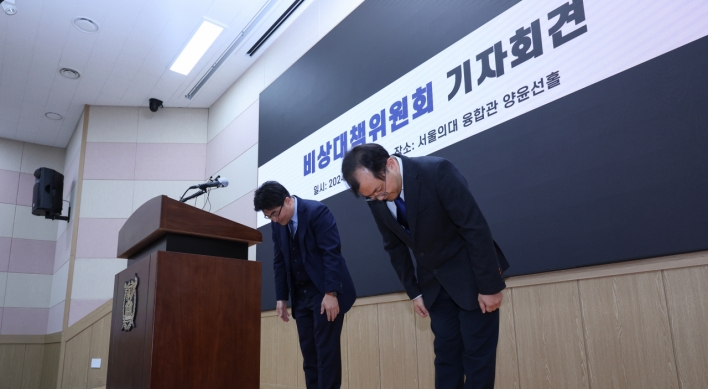Korea has gotten one step closer to manufacturing passenger aircraft for commercial purposes as KC-100, dubbed as “Naraon,” soared into the sky last Wednesday in Sacheon, South Gyeongsang Province.
Ac cording to the Ministry of Land, Transport and Maritime Affairs and Korea Aerospace Industries, this has made Korea the 28th country to manufacture civil aircraft. Obviously, this is another big stride for the Korean aviation industry after the recent achievements in the exports of its first indigenous military trainers, the T-50s.
cording to the Ministry of Land, Transport and Maritime Affairs and Korea Aerospace Industries, this has made Korea the 28th country to manufacture civil aircraft. Obviously, this is another big stride for the Korean aviation industry after the recent achievements in the exports of its first indigenous military trainers, the T-50s.
Not surprisingly, the development of the civil aircraft looks beyond the Korean domestic market. The aviation industry has been marked as a new frontier for the future of the Korean manufacturing industry, as indicated by sporadic statements from officials in the governmental agencies repeating Korea’s interest in the global market of medium-size (50-to-100 seat) passenger aircraft.
This is the market which is dominated by a handful of major players including Bombardier of Canada and Embraer of Brazil. Unlike the large-passenger-aircraft market which is dominated by Boeing and Airbus, the medium-size market has been expected to present a small window of opportunity for new participants.
The successful test flight of Naraon was a meaningful first step for the ambitious plan of KAI. Having watched Korea’s penetration into the global markets of automobiles and commercial vessels as latecomers, other countries and aircraft manufacturers may have observed the debut with interest.
The global civil aircraft market has been very competitive. Development and exports of civil aircraft have frequently caused all-out trade wars between the competing countries. In the late 1990s and early 2000s, Brazil and Canada were involved in multiple trade disputes at the WTO, accusing each other for illegal support for their respective aircraft manufacturers who were competing in the global market.
Since 2004, the battle front has moved to the large civil aircraft market, where the United States and the European Union have been engaged in a series of high-profile subsidy disputes of their own. The U.S.-EU disputes concern large civil aircraft manufactured by Boeing of the United States and Airbus of the EU.
As the competition between the two aviation giants in the international market intensified with the introduction of new aircraft (Boeing’s B777 and Airbus’ A380), the two countries started to accuse each other of providing illegal subsidies in many forms to Boeing and Airbus, respectively. Although decisions for some component disputes have been rendered, the U.S.-EU aircraft disputes are still pending.
The aircraft disputes for the past decade tell us many things. First of all, they indicate that development and establishment of the aircraft manufacturing industry are only feasible through long-term planning and thorough coordination of a national government.
At least in the initial stage, that is the case. With the enormity of the initial investment in research and development and the magnitude of mobilization of the national technologies and resources, this is rarely an industry in which an individual company can decide on its own to join and thrive.
At the same time, the WTO Agreement basically stipulates that a government should not intervene in the private sector such as the aviation industry. So, there is a de facto conflict between the reality and the norm. This dilemma explains why we have seen all these disputes involving aircraft of all sizes during the last decade.
Once the Naraon four-seater evolves to a 50-seat passenger plane, as envisioned by the blueprint and Korea’s own commercial aircraft make a splash in the international market, it is quite possible that these aviation trade battles will repeat themselves.
As a matter of fact, Korea has been particularly vulnerable in subsidy disputes. It was not long ago when Korea was involved in subsidy disputes with major trading partners because of commercial vessels and semiconductors, two major Korean exports.
One good thing is that there is always a benefit for latecomers. The recent disputes between the United States and the EU provide ample examples that other countries might want to carefully scrutinize, if they want to avoid future pitfalls in their own endeavors. One can see that all things being equal, a significant difference can be made depending upon how governmental policies and assistance programs are formulated and structured.
Framed differently, a rough map of pitfalls is already available for a new entrant and there is no need to re-invent the wheel. The KC-100’s successful virgin flight provides another reason that Korea should remain apprised of the continuing saga of the aircraft disputes.
By Lee Jae-min
Lee Jae-min is a professor of law at the School of Law, Hanyang University, in Seoul. Formerly he practiced law as an associate attorney with Willkie Farr & Gallagher LLP. ― Ed.
Ac
 cording to the Ministry of Land, Transport and Maritime Affairs and Korea Aerospace Industries, this has made Korea the 28th country to manufacture civil aircraft. Obviously, this is another big stride for the Korean aviation industry after the recent achievements in the exports of its first indigenous military trainers, the T-50s.
cording to the Ministry of Land, Transport and Maritime Affairs and Korea Aerospace Industries, this has made Korea the 28th country to manufacture civil aircraft. Obviously, this is another big stride for the Korean aviation industry after the recent achievements in the exports of its first indigenous military trainers, the T-50s. Not surprisingly, the development of the civil aircraft looks beyond the Korean domestic market. The aviation industry has been marked as a new frontier for the future of the Korean manufacturing industry, as indicated by sporadic statements from officials in the governmental agencies repeating Korea’s interest in the global market of medium-size (50-to-100 seat) passenger aircraft.
This is the market which is dominated by a handful of major players including Bombardier of Canada and Embraer of Brazil. Unlike the large-passenger-aircraft market which is dominated by Boeing and Airbus, the medium-size market has been expected to present a small window of opportunity for new participants.
The successful test flight of Naraon was a meaningful first step for the ambitious plan of KAI. Having watched Korea’s penetration into the global markets of automobiles and commercial vessels as latecomers, other countries and aircraft manufacturers may have observed the debut with interest.
The global civil aircraft market has been very competitive. Development and exports of civil aircraft have frequently caused all-out trade wars between the competing countries. In the late 1990s and early 2000s, Brazil and Canada were involved in multiple trade disputes at the WTO, accusing each other for illegal support for their respective aircraft manufacturers who were competing in the global market.
Since 2004, the battle front has moved to the large civil aircraft market, where the United States and the European Union have been engaged in a series of high-profile subsidy disputes of their own. The U.S.-EU disputes concern large civil aircraft manufactured by Boeing of the United States and Airbus of the EU.
As the competition between the two aviation giants in the international market intensified with the introduction of new aircraft (Boeing’s B777 and Airbus’ A380), the two countries started to accuse each other of providing illegal subsidies in many forms to Boeing and Airbus, respectively. Although decisions for some component disputes have been rendered, the U.S.-EU aircraft disputes are still pending.
The aircraft disputes for the past decade tell us many things. First of all, they indicate that development and establishment of the aircraft manufacturing industry are only feasible through long-term planning and thorough coordination of a national government.
At least in the initial stage, that is the case. With the enormity of the initial investment in research and development and the magnitude of mobilization of the national technologies and resources, this is rarely an industry in which an individual company can decide on its own to join and thrive.
At the same time, the WTO Agreement basically stipulates that a government should not intervene in the private sector such as the aviation industry. So, there is a de facto conflict between the reality and the norm. This dilemma explains why we have seen all these disputes involving aircraft of all sizes during the last decade.
Once the Naraon four-seater evolves to a 50-seat passenger plane, as envisioned by the blueprint and Korea’s own commercial aircraft make a splash in the international market, it is quite possible that these aviation trade battles will repeat themselves.
As a matter of fact, Korea has been particularly vulnerable in subsidy disputes. It was not long ago when Korea was involved in subsidy disputes with major trading partners because of commercial vessels and semiconductors, two major Korean exports.
One good thing is that there is always a benefit for latecomers. The recent disputes between the United States and the EU provide ample examples that other countries might want to carefully scrutinize, if they want to avoid future pitfalls in their own endeavors. One can see that all things being equal, a significant difference can be made depending upon how governmental policies and assistance programs are formulated and structured.
Framed differently, a rough map of pitfalls is already available for a new entrant and there is no need to re-invent the wheel. The KC-100’s successful virgin flight provides another reason that Korea should remain apprised of the continuing saga of the aircraft disputes.
By Lee Jae-min
Lee Jae-min is a professor of law at the School of Law, Hanyang University, in Seoul. Formerly he practiced law as an associate attorney with Willkie Farr & Gallagher LLP. ― Ed.


![[Exclusive] Korean military set to ban iPhones over 'security' concerns](http://res.heraldm.com/phpwas/restmb_idxmake.php?idx=644&simg=/content/image/2024/04/23/20240423050599_0.jpg&u=20240423183955)
![[AtoZ into Korean mind] Humor in Korea: Navigating the line between what's funny and not](http://res.heraldm.com/phpwas/restmb_idxmake.php?idx=644&simg=/content/image/2024/04/22/20240422050642_0.jpg&u=)


![[Graphic News] 77% of young Koreans still financially dependent](http://res.heraldm.com/phpwas/restmb_idxmake.php?idx=644&simg=/content/image/2024/04/22/20240422050762_0.gif&u=)











![[Today’s K-pop] Ateez confirms US tour details](http://res.heraldm.com/phpwas/restmb_idxmake.php?idx=642&simg=/content/image/2024/04/23/20240423050700_0.jpg&u=)